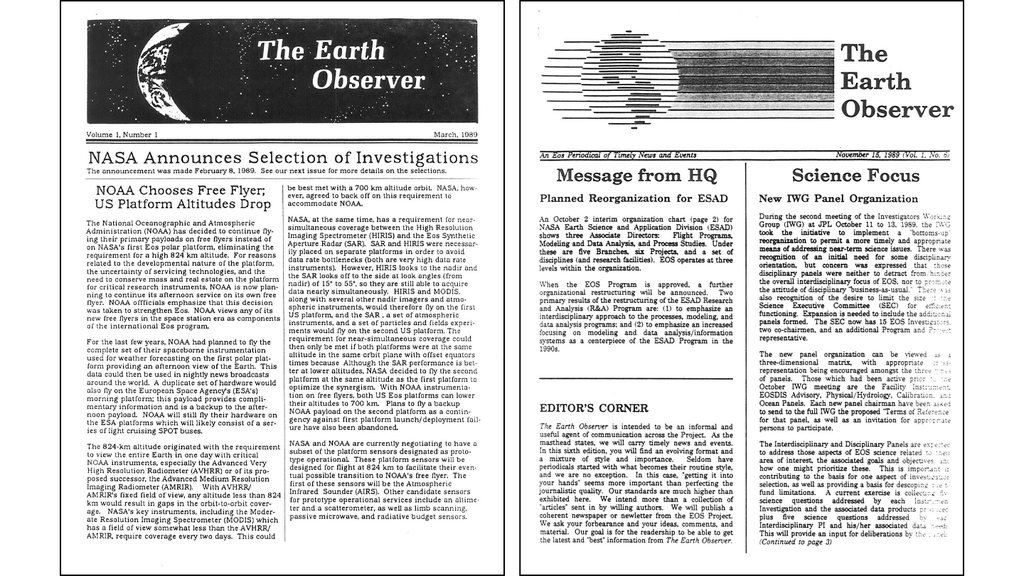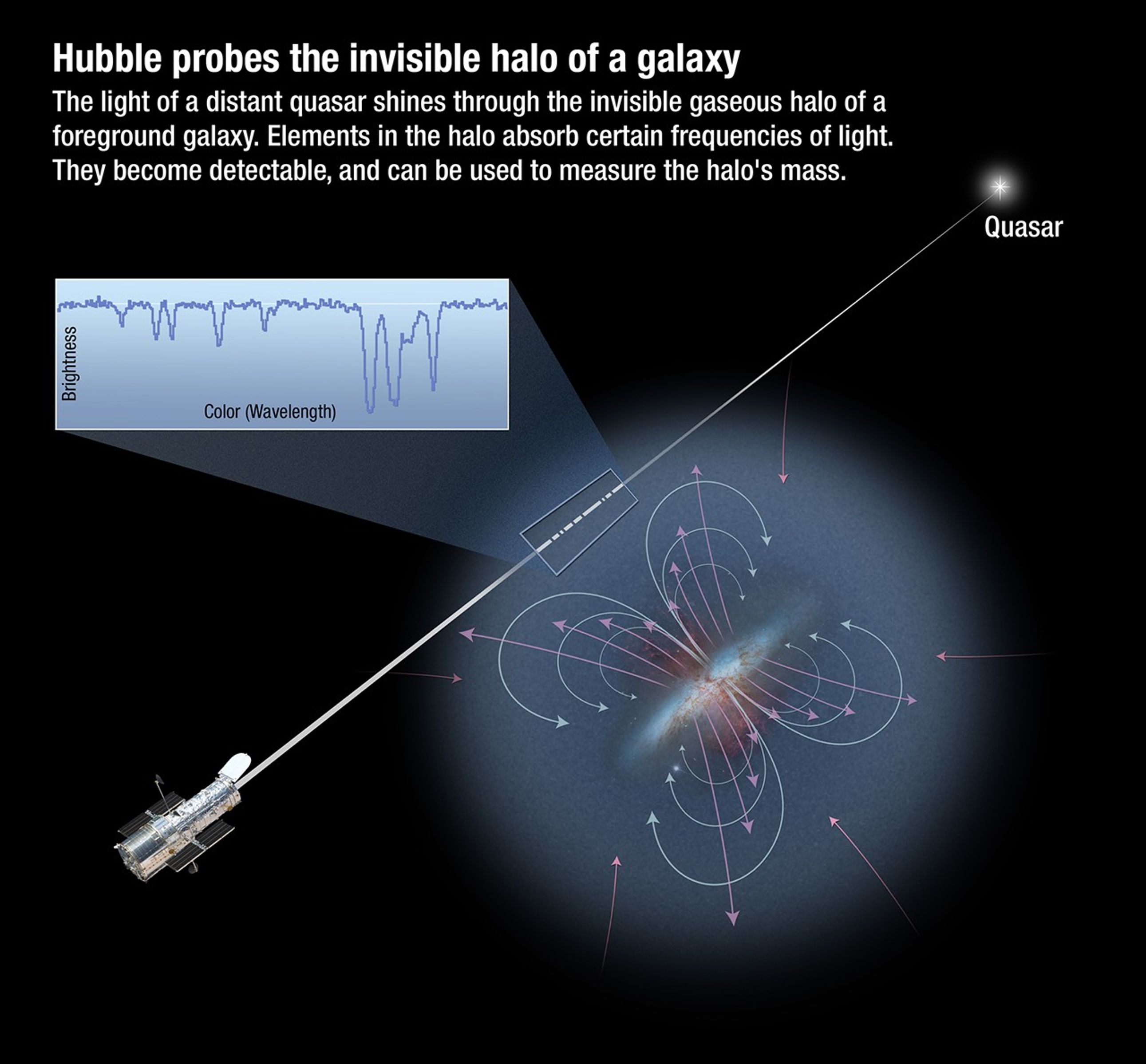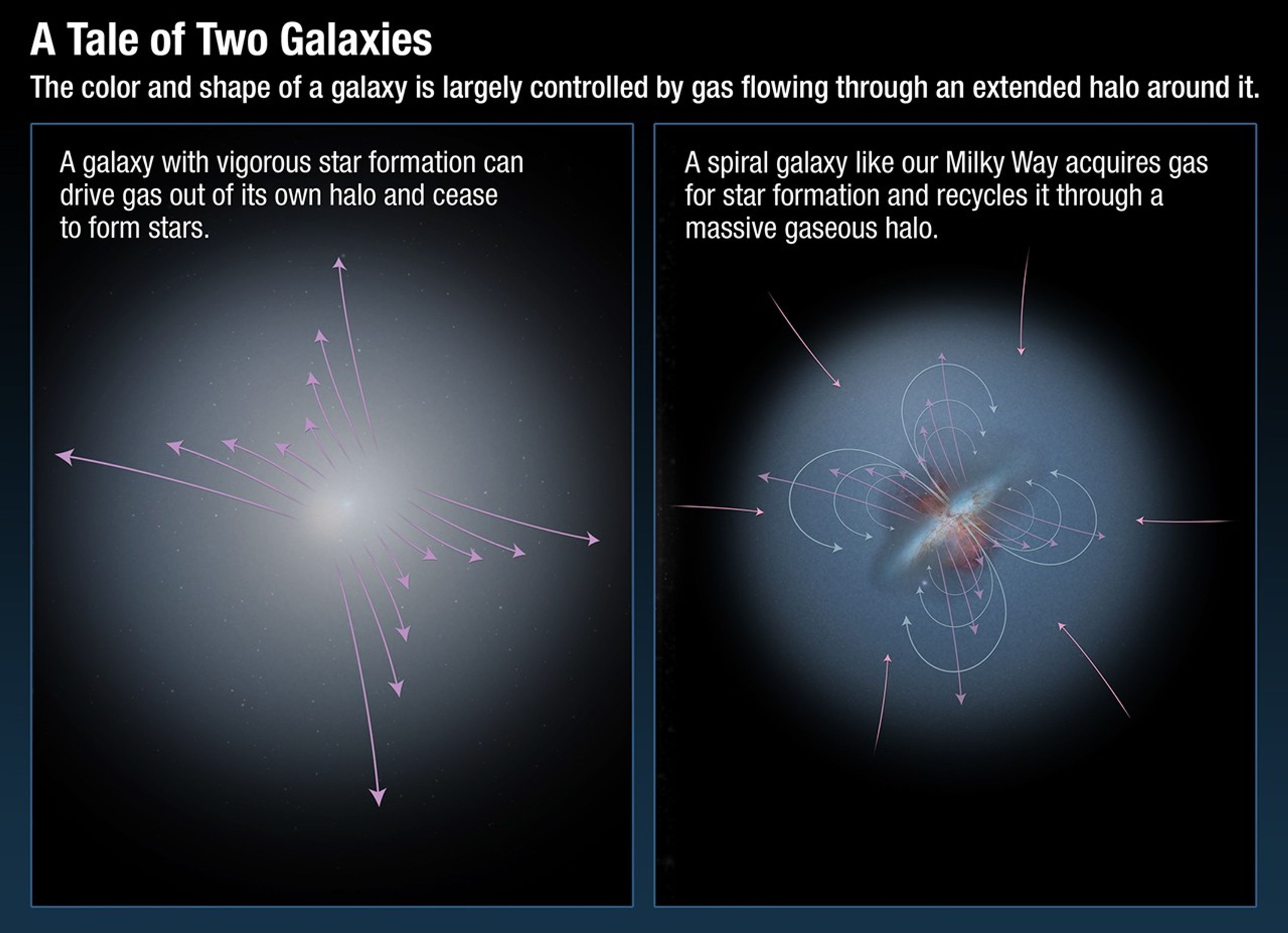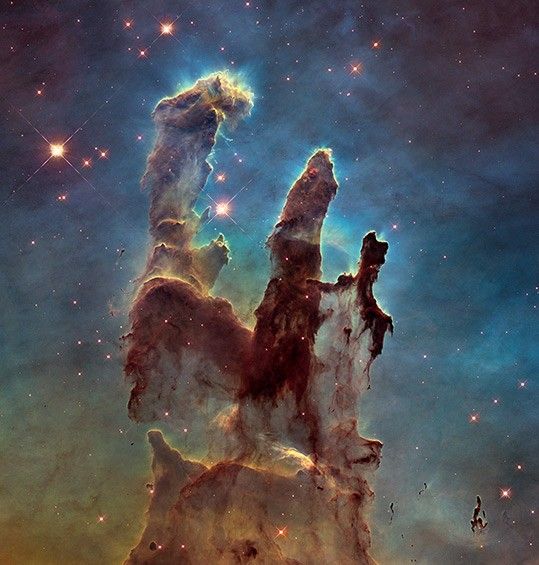Galaxies learned to "go green" early in the history of the universe, continuously recycling immense volumes of hydrogen gas and heavy elements to build successive generations of stars stretching over billions of years.
This ongoing recycling keeps galaxies from emptying their "fuel tanks" and therefore stretches out their star-forming epoch to over 10 billion years. However, galaxies that ignite a rapid firestorm of star birth can blow away their remaining fuel, essentially turning off further star-birth activity.
This conclusion is based on a series of Hubble Space Telescope observations that flexed the special capabilities of its comparatively new Cosmic Origins Spectrograph (COS) to detect otherwise invisible mass in the halo of our Milky Way and a sample of more than 40 other galaxies. Data from large ground-based telescopes in Hawaii, Arizona, and Chile also contributed to the studies by measuring the properties of the galaxies.
This invisible mass is made up of normal matter – hydrogen, helium, and heavier elements such as carbon, oxygen, nitrogen, and neon – as opposed to dark matter that is an unknown exotic particle pervading space.
The results are being published in three papers in the November 18 issue of Science magazine. The leaders of the three studies are Nicolas Lehner of the University of Notre Dame in South Bend, Ind.; Jason Tumlinson of the Space Telescope Science Institute in Baltimore, Md.; and Todd Tripp of the University of Massachusetts at Amherst.
The Key Findings
The color and shape of a galaxy is largely controlled by gas flowing through an extended halo around it. All modern simulations of galaxy formation find that they cannot explain the observed properties of galaxies without modeling the complex accretion and "feedback" processes by which galaxies acquire gas and then later expel it after processing by stars. The three studies investigated different aspects of the gas-recycling phenomenon.
"Our results confirm a theoretical suspicion that galaxies expel and can recycle their gas, but they also present a fresh challenge to theoretical models to understand these gas flows and integrate them with the overall picture of galaxy formation," Tumlinson says.
The team used COS observations of distant stars to demonstrate that a large mass of clouds is falling through the giant corona halo of our Milky Way, fueling its ongoing star formation. These clouds of ionized hydrogen reside within 20,000 light-years of the Milky Way disk and contain enough material to make 100 million suns. Some of this gas is recycled material that is continually being replenished by star formation and the explosive energy of novae and supernovae, which kicks chemically enriched gas back into the halo; the remainder is gas being accreted for the first time. The infalling gas from this vast reservoir fuels the Milky Way with the equivalent of about a solar mass per year, which is comparable to the rate at which our galaxy makes stars. At this rate the Milky Way will continue making stars for another billion years by recycling gas into the halo and back onto the galaxy. "We now know where is the missing fuel for galactic star formation," Lehner concludes. "We now have to find out its birthplace."
One goal of the studies was to study how other galaxies like our Milky Way accrete mass for star making. But instead of widespread accretion, the team found nearly ubiquitous halos of hot gas surrounding vigorous star-forming galaxies. These galaxy halos, rich in heavy elements, extend as much as 450,000 light-years beyond the visible portions of their galactic disks. The surprise was discovering how much mass in heavy elements is far outside a galaxy. COS measured 10 million solar masses of oxygen in a galaxy's halo, which corresponds to about 1 billion solar masses of gas – as much as in the entire interstellar medium between stars in a galaxy's disk. They also found that this gas is nearly absent from galaxies that have stopped forming stars. This is evidence that widespread outflows, rather than accretion, determine a galaxy's fate. "We didn't know how much mass was there in these gas halos, because we couldn't do these observations until we had COS," Tumlinson says. "This stuff is a huge component of galaxies but can't be seen in any images."
He points out that because so much of the heavy elements has been ejected into the halos instead of sticking around in the galaxies, the formation of planets, life, and other things requiring heavy elements could have been delayed in these galaxies.
The COS data also demonstrate that those galaxies forming stars at a very rapid rate, perhaps a hundred solar masses per year, can drive 2-million-degree gas very far out into intergalactic space at speeds of up to 2 million miles per hour. That's fast enough for the gas to escape forever and never refuel the parent galaxy. While hot plasma "winds" from galaxies have been known for some time, the new COS observations reveal that hot outflows extend to much greater distances than previously thought and can carry a tremendous amount of mass out of a galaxy. Some of the hot gas is moving more slowly and could eventually be recycled. The Hubble observations show how gas-rich star-forming spiral galaxies can evolve to quiescent elliptical galaxies that no longer have star formation. "So not only have we found that star-forming galaxies are pervasively surrounded by large halos of hot gas," says Tripp, "we have also observed that hot gas in transit – we have caught the stuff in the process of moving out of a galaxy and into intergalactic space."
The light emitted by this hot plasma is invisible, so the researchers used COS to detect the presence of the gas by the way it absorbs certain colors of light from background quasars. The brightest objects in the universe, quasars are the brilliant cores of active galaxies that contain rapidly accreting supermassive black holes. The quasars serve as distant lighthouse beacons that shine through the gas-rich "fog" of hot plasma encircling galaxies. At ultraviolet wavelengths, COS is sensitive to absorption from many ionized heavy elements, such as nitrogen, oxygen, and neon. COS's high sensitivity allows many galaxies that happen to lie in front of the much more distant quasars to be studied. The ionized heavy elements serve as proxies for estimating how much mass is in a galaxy's halo.
"Only with COS can we now address some of the most crucial questions that are at the forefront of extragalactic astrophysics," Tumlinson says.
About the HST DataNote: The work presented in these papers is based in part on ground-based observations from the following telescope observatories: Keck Observatory in Hawaii, the Multiple Mirror Telescope (MMT) and the Large Binocular Telescope (LBT) in Arizona, and the Magellean Telescopes in Chile.
The science findings in this release are based on HST data from the following proposals:11741: T. Tripp (University of Massachusetts, Amherst), J. Prochaska (University of California, Santa Cruz), C. Howk and N. Lehner (University of Notre Dame), K. Sembach (STScI), and D. Bowen and E. Jenkins (Princeton University);11598: J. Tumlinson (STScI), T. Tripp (University of Massachusetts, Amherst), J. Prochaska (University of California, Santa Cruz), K. Sembach (STScI), R. Dave (University of Arizona), D. Weinberg (Ohio State University), N. Katz (University of Massachusetts), and B. Oppenheimer (University of Arizona); and11592: N. Lehner, C. Howk, and W. Zech (University of Notre Dame). Archival STIS data were also used in these findings.
- Instrument: COS
- Gratings: G130M and G160M
- Exposure Dates: 2009-2011

































